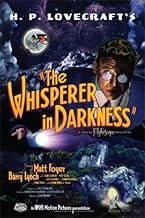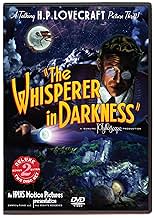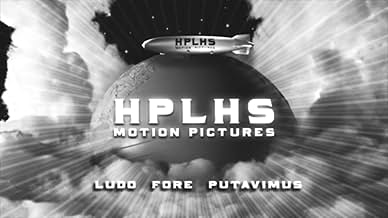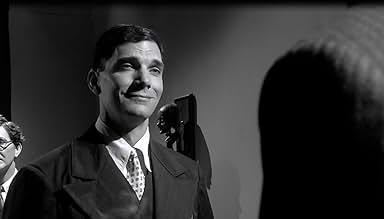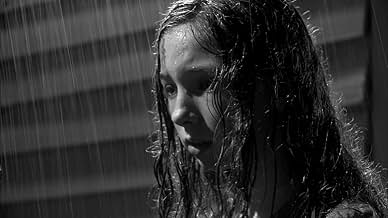IMDb रेटिंग
6.5/10
3.8 हज़ार
आपकी रेटिंग
अपनी भाषा में प्लॉट जोड़ेंBased on the H. P. Lovecraft story of the same name, a folklorist investigates reports of unusual creatures in Vermont only to uncover more than he bargained forBased on the H. P. Lovecraft story of the same name, a folklorist investigates reports of unusual creatures in Vermont only to uncover more than he bargained forBased on the H. P. Lovecraft story of the same name, a folklorist investigates reports of unusual creatures in Vermont only to uncover more than he bargained for
- निर्देशक
- लेखक
- स्टार
- पुरस्कार
- 3 कुल नामांकन
Conor Timmis
- Porter
- (काटे गए सीन)
फ़ीचर्ड समीक्षाएं
I am an avid fan of the writings of Lovecraft, well, and anything Lovecraftian in general, and happened to come across "The Whisperer in Darkness" by sheer luck. I didn't have my hopes up, because most previous movies based on Lovecraft stories had been off key or had too much focus on special effects and putting the ominous dread of the core of the story in the background.
However, as with the 2005 version of "The Call of Cthulhu", I was more than genuinely surprised in a good way with the 2011 film version of "The Whisperer in Darkness". This was right on the spot in every aspect; focusing on the storytelling, the build up of the cosmic dread and the despair of the protagonist.
The actors in the movie were doing good jobs bringing the story to life through their characters. And director Sean Branney really capture the essence of the timeless writing of Lovecraft.
However, personally, I am not overly keen on movies in black and white, as colors add so much more flavor to the movie experience. But keeping it in black and white works well enough for the movie, given the thematic setting of H.P. Lovecraft's mythos and universe.
"The Whisperer in Darkness" is a MUST watch for any fan of Lovecraft. And I rate it a solid seven out of ten stars. If the movie had been in color, the rating would have been eight. Visuals are important in the movie media.
However, as with the 2005 version of "The Call of Cthulhu", I was more than genuinely surprised in a good way with the 2011 film version of "The Whisperer in Darkness". This was right on the spot in every aspect; focusing on the storytelling, the build up of the cosmic dread and the despair of the protagonist.
The actors in the movie were doing good jobs bringing the story to life through their characters. And director Sean Branney really capture the essence of the timeless writing of Lovecraft.
However, personally, I am not overly keen on movies in black and white, as colors add so much more flavor to the movie experience. But keeping it in black and white works well enough for the movie, given the thematic setting of H.P. Lovecraft's mythos and universe.
"The Whisperer in Darkness" is a MUST watch for any fan of Lovecraft. And I rate it a solid seven out of ten stars. If the movie had been in color, the rating would have been eight. Visuals are important in the movie media.
Really enjoyed the clean look of this film in black & white, and also the sound editing. This is probably the classiest example of what can be achieved with a limited budget when the filmmakers obviously have a love of the material which shines through. The script is faithful to Lovecraft yet it does cuts down on a lot of the excessive verbiage to make it somewhat more palatable to a modern audience. The pace progressively builds and does pay off. The standout performance is from the adorable Autumn Wendell "Hanna Masterson" who embodies the film and is very effective at being terrified, yet innocent at the same time. A perfect fit to a film which achieves the same things.
This black and white SF mystery is in every aspect designed to conjure up the experience of reading Lovecraft. Lovecraft is respected both with the story and atmosphere, which makes the film one of the rare true adaptations of this great horror-fantasy author. Its style resembles Film Noir quite a lot, and only quality of the picture breaks down the illusion that you are watching a movie from the first half of the last century. Even the opening and the ending credits are archaic. This is an independent low-budget film, produced by "The H. P. Lovecraft Historical Society". Despite the low budget and unknown actors, the film is very well shot and acted, and the lack of money for quality CGI is offset by excellent directorial tricks that are, at least for my taste, far more effective in intimidating than the technically costly, but essentially cheap CGI explicitness. Unfortunately, towards the end, they decided to break the tension, gradually built with quality hints, by an explicit depiction of extraterrestrial beings. But even that did not turn out to be so bad to completely spoil the experience, although I would personally prefer if they have abstained from this move. Overall, I am very pleased and I would like to see more of such adaptations of my favorite authors in the future. The only thing from this century with which I could compare it, on the basis of personal experience, is the video game "Undying" by Clive Barker from 2001. If you played it and liked it, you will probably like "The Whisperer in Darkness". If you did not, and you like this movie, you should try out the excellent interactive horror of my favorite video game.
7/10
7/10
It is so hard to find a good Lovecraft movie. But this one is excellent. It does not rely on cheap jump scares or the like. It builds up a creepy atmosphere that scares you by suggesting the unimaginable otherworldly. Just like Lovecraft, it presents a vision of superior forces beyond the control of humanity. The acting is great and the screenplay is very fluid. The set design is amazing as well. Sadly, the digital effects are rather noticeable and cheap. Especially on the creatures. I would have really liked to see some good old stop motion, especially on a film that looks so eerily like an old 30s or 40s horror movie.
One cannot help but give full marks to the H.P. Lovecraft Historical Society for their efforts to bring H. P. Lovecraft's eerie stories to the screen in a manner in keeping with the texture and mood of the original material. Although there have been other attempts to film Lovecraft stories, most have generally been unsatisfying failures due to misguided attempts to modernize or glamorize them. Not so with HPLHS, who have gone out their way to keep faithful to the period and locales in which the tales were set, even going so far as give the film the feel of an early-1930s black-and-white movie. Even their logo is an homage to the the old Universal Studios logo of the early 1930s (the studio which produced such classic horror movies as Frankenstein, Dracula and The Mummy), replacing the familiar airplane-circling-the-earth with a dirigible.
The plot involves Albert Wilmarth, a college anthropology professor specializing in folklore, who becomes intrigued by a series of unusual newspaper stories reported from a rural part of Vermont after a period of particularly heavy rains. It seems that bodies have been observed washing down from the mountains in the swollen rivers, bodies which are, reportedly, neither human nor animal. The bodies apparently also recall, among the older inhabitants, old tales of strange beings that live in remote parts of the hills, beings that are neither human nor animal, and possibly not even of terrestrial origin. Wilmarth begins his investigation into these stories on the basis that they are nothing more than mere interesting folklore, but soon finds himself dealing with something far more sinister.
Admittedly, the producers of the movie added some material and characters not present in the original story. In fact, the short story actually ends at a point only about one hour into the film. However, the original version was, after all, only a short story, and I suppose the makers felt that they had to add some material to the plot in order to expand the short story into a full-length movie. nevertheless, the movie still does a far better job of evoking the feel of H.P. Lovecraft's writing than any other movie versions of his works, with the only possible exception being the resent silent film version of The Call of Cathulhu, which was made by the same producers.
One addition to the film is a debate staged between the protagonist, Professor Wilmarth, and Charles Fort. While that was not a part of H.P. Lovecraft's original story, it is interesting period touch because Charles Fort was actually a real person, a celebrated and controversial author of the early 1900s who was known to contemporaries as "The Mad Genius of the Bronx". Fort, who died in 1932, wrote about what are now called paranormal phenomena before that term was even invented, and is credited, among other things, with coining the word "teleportation".
The plot involves Albert Wilmarth, a college anthropology professor specializing in folklore, who becomes intrigued by a series of unusual newspaper stories reported from a rural part of Vermont after a period of particularly heavy rains. It seems that bodies have been observed washing down from the mountains in the swollen rivers, bodies which are, reportedly, neither human nor animal. The bodies apparently also recall, among the older inhabitants, old tales of strange beings that live in remote parts of the hills, beings that are neither human nor animal, and possibly not even of terrestrial origin. Wilmarth begins his investigation into these stories on the basis that they are nothing more than mere interesting folklore, but soon finds himself dealing with something far more sinister.
Admittedly, the producers of the movie added some material and characters not present in the original story. In fact, the short story actually ends at a point only about one hour into the film. However, the original version was, after all, only a short story, and I suppose the makers felt that they had to add some material to the plot in order to expand the short story into a full-length movie. nevertheless, the movie still does a far better job of evoking the feel of H.P. Lovecraft's writing than any other movie versions of his works, with the only possible exception being the resent silent film version of The Call of Cathulhu, which was made by the same producers.
One addition to the film is a debate staged between the protagonist, Professor Wilmarth, and Charles Fort. While that was not a part of H.P. Lovecraft's original story, it is interesting period touch because Charles Fort was actually a real person, a celebrated and controversial author of the early 1900s who was known to contemporaries as "The Mad Genius of the Bronx". Fort, who died in 1932, wrote about what are now called paranormal phenomena before that term was even invented, and is credited, among other things, with coining the word "teleportation".
क्या आपको पता है
- ट्रिवियाCharles Fort (1874-1932) was a real person, a collector of accounts of unusual phenomena, disdaining scientists who would try to explain it all away, as seen in the film.
- गूफ़When Professor Wilmarth is waiting for young Mr. Akeley at the Boston train station, Wilmarth turns his head to see that the train is approaching. Although the image is out of focus, it is clearly a modern train, not one that would be seen in the 1920's.
- क्रेज़ी क्रेडिटAfter the FBI copyright warning: "all video involving fungal beings from the farther reaches of the solar system is carefully monitored by the Mi-Go, who deal harshly with those who duplicate and upload to the internet without permission."
टॉप पसंद
रेटिंग देने के लिए साइन-इन करें और वैयक्तिकृत सुझावों के लिए वॉचलिस्ट करें
- How long is The Whisperer in Darkness?Alexa द्वारा संचालित
विवरण
- रिलीज़ की तारीख़
- कंट्री ऑफ़ ओरिजिन
- आधिकारिक साइट
- भाषा
- इस रूप में भी जाना जाता है
- 克蘇魯怪談:黑暗細語
- उत्पादन कंपनियां
- IMDbPro पर और कंपनी क्रेडिट देखें
- चलने की अवधि1 घंटा 43 मिनट
- रंग
- पक्ष अनुपात
- 1.78 : 1
इस पेज में योगदान दें
किसी बदलाव का सुझाव दें या अनुपलब्ध कॉन्टेंट जोड़ें

टॉप गैप
By what name was The Whisperer in Darkness (2011) officially released in India in English?
जवाब

